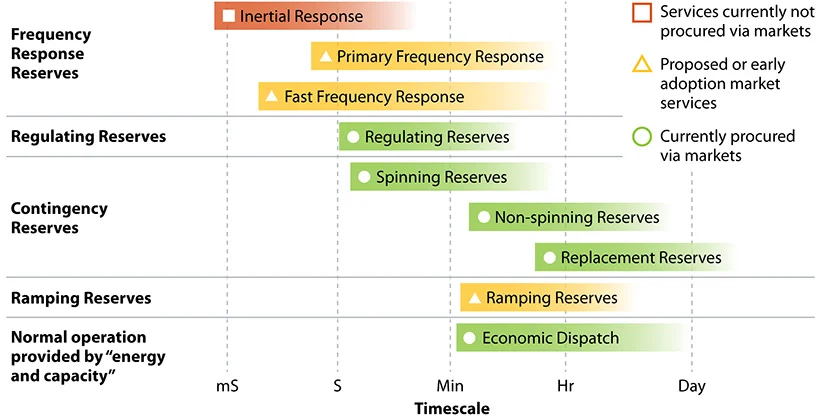Operational Reliability Basics
Operational reliability is the ability of the power system to balance supply and demand in real time and rapidly respond to unexpected events.
NREL research examines how renewable energy resources can help maintain grid stability across multiple timescales.

Graph showing the timescale in which a power grid responds with energy reserves to electricity demands during an unexpected event.
Maintaining Stable Frequency
Maintaining stable frequency is important for a reliable grid. When a large power plant or transmission line fails (which often happens without warning), the mismatch of supply and demand can result in a decline in system frequency, and if not rapidly addressed, can result in blackouts.
To maintain stable frequency, the grid relies on two types of frequency responsive reserves, which rapidly and automatically respond to changes in frequency. Devices called governors are located on generators to detect changes in frequency. The governors measure how fast generators are spinning and tell power plants to speed up or slow down. But it takes time for this measurement and response to occur, so inertia on the grid—energy stored in large rotating generators and some industrial motors that give them the tendency to remain rotating—allows time for the systems to respond and change power output.
These reserves are traditionally provided by large rotating generators in fossil, nuclear, and hydroelectric plants. Wind, solar, and many forms of energy storage use power electronic-based generators (inverters) that act differently, and in particular, do not inherently provide inertia. However, inverter-based resources can respond faster than traditional generators, and both solar and wind can provide operating reserves by reducing their output in the same manner as other resources, while wind can also provide reserves by extracting stored kinetic energy from rotating wind turbines. By providing fast frequency response, inverter-based resources can reduce the amount of inertia required.
Learn more about inertia's role in maintaining a reliable power grid in this video and understand how reliability can still be maintained on future grids with more wind and solar—and thus less inertia. Text version
Responding to Renewable Variability
Wind and solar can experience short-term fluctuations in supply and demand, such as a cloud passing over a solar farm. The grid maintains regulating reserves to respond to normal variations in supply and demand, and wind and solar can increase this requirement. NREL research has examined the reserves required as solar and wind contributions increase, and the important role of resource spatial variability, which reduces the impact of individual resources. Research also demonstrates the ability of wind and solar to provide their own reserves, complemented by other resources, including energy storage. NREL also has demonstrated the role of newer "slower" reserves that are less costly and better suited to address wind and solar variability over longer timescales.
Additional Resources
Planning for Reliable Operations
Causes of Three Recent Major Blackouts and What Is Being Done in Response, NREL Fact Sheet (2024)
How the U.S. Power Grid Kept the Lights on In Summer 2024, NREL Technical Report (2024)
Maintaining a Reliable Future Grid With More Wind and Solar, NREL Fact Sheet (2024)
Inertia on the Power Grid, NREL Fact Sheet (2020)
Inertia on the Power Grid, NREL Technical Report (2020)
An Introduction to Grid Services: Concepts, Technical Requirements, and Provision From Wind, NREL Technical Report (2019)
Share
Last Updated Aug. 27, 2025
